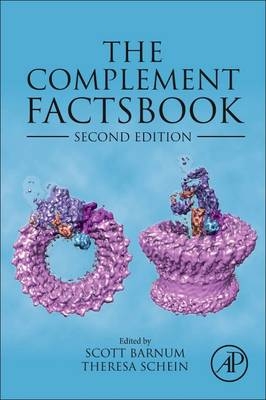
The Complement FactsBook
Academic Press Inc (Verlag)
978-0-12-810420-0 (ISBN)
This new edition is expanded to include relevant updates and topics that have evolved since the last edition was published, including C1q and Lectins, C3 Family, Serine Proteases, Serum Regulators of Complement Activation, Cell Surface Proteins, and Terminal Pathway Proteins. Domain Structure diagrams are incorporated to clearly illustrate the relationships between all the complement proteins, both within families and between families.
Scott Barnum received his B.S. in Biology (cum laude) from Loyola University in Maryland and his Ph.D. from the University of Alabama at Birmingham where he worked on the biosynthesis of factor D for his thesis studies. He then pursued postdoctoral studies on the genomic organization of several complement genes in the Department of Immunology at the Scripps Research Institute. He returned to UAB as a member of the faculty in the Department of Microbiology and holds secondary appointments in the Department of Neurology and the Division of Clinical Immunology and Rheumatology. Since returning to UAB, Dr. Barnum’s research has focused primarily on the role of complement in the central nervous system. Through a combination of in vitro and in vivo studies, his lab demonstrated that glia cells and neurons produce a variety of complement proteins and receptors. Subsequently, the lab identified the role of complement in numerous animal models of human disease including, traumatic brain injury, multiple sclerosis, bacterial meningitis, stroke, and cerebral malaria. In addition to numerous teaching awards, he produced the first high quality animated videos for teaching complement activation and biological functions. Dr. Barnum is currently working on the development of complement diagnostics for use in a variety of infectious disease and autoimmune indications. Theresa Schein received her B.S. in Biology (cum laude) from the University of South Carolina, Aiken where she studied HIV and molecular cloning. Dr. Schein then attended the University of Alabama at Birmingham where she earned her Ph.D. on the role of complement in the development and progression of cerebral malaria. Publishing numerous manuscripts on the role of complement components in experimental cerebral malaria, her studies were seminal in establishing the therapeutic potential of inhibiting the complement terminal pathway in this infectious disease. Upon graduation, she received the Dean’s Outstanding Student Award, among others. She then pursued a short postdoctoral study on the role of the terminal complement pathway in amyotrophic lateral sclerosis at UAB, before transitioning to an entrepreneurial role in a small startup out of St. Louis. While her collaborative efforts have spanned her complement research from infectious to autoimmune disease as demonstrated by her publishing record, Dr. Ramos is currently working on the development of complement centric diagnostics for use in bacterial meningitis.
1. Introduction 2. The Complement Proteins C1q and the Collectins Serine proteases C3 Family Terminal Pathway Components Regulations of Complement Activation (RCA) Cell Surface Receptors Miscellaneous Complement Components
| Erscheinungsdatum | 29.01.2018 |
|---|---|
| Reihe/Serie | Factsbook |
| Verlagsort | San Diego |
| Sprache | englisch |
| Maße | 152 x 229 mm |
| Gewicht | 820 g |
| Themenwelt | Naturwissenschaften ► Biologie ► Biochemie |
| Naturwissenschaften ► Biologie ► Mikrobiologie / Immunologie | |
| ISBN-10 | 0-12-810420-1 / 0128104201 |
| ISBN-13 | 978-0-12-810420-0 / 9780128104200 |
| Zustand | Neuware |
| Haben Sie eine Frage zum Produkt? |
aus dem Bereich


